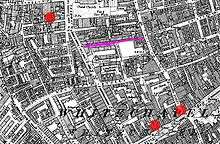Flower and Dean Street

Flower and Dean Street was a road situated at the heart of the Spitalfields rookery in the East End of London. It was one of the most notorious slum areas of the Victorian era and was closely associated with the victims of Jack the Ripper. It was described in 1883 as "perhaps the foulest and most dangerous street in the whole metropolis".[1]
The street was built in the 1650s and rebuilt in parts in the eighteenth. The name evolved from that of two local bricklayers, John Flower and Gowan Dean,[2] who were associated with its construction. By the nineteenth century the back gardens of the original tenements had been built over for narrow courts and alleys and the area had become a slum. The poverty and deprivation of the area was reflected by the greatest concentration of common lodging-houses in London. In 1871 there were thirty one such places in the street. These, as well as providing accommodation for the desperate and the destitute were a focus for the activities of local thieves and prostitutes. Already in 1865 the street was referred to by the artist Ford Madox Brown as the epitome of social degradation in his description of his painting Work. Brown describes a vagabond depicted in the picture as living in Flower and Dean Street, "haunt of vice", "where the policemen walk two and two, and the worst cut-throats surround him".[3]
Slum clearance began 1881-83. The sanguinary activities of the serial killer known as Jack the Ripper in the area in 1888 prompted further redevelopment. Two of his victims, Elizabeth Stride and Catherine Eddowes, resided in two common lodging houses on the street. The scandal of these killings prompted 'respectable' landlords to divest themselves of property here and all traces of the street were virtually eradicated between 1891 and 1894 in a major slum clearance programme.[4] There is now a housing block where the street used to be.
A 2008 Scotland Yard geographical profile of Jack the Ripper concluded that he most probably lived in this very street where two of his victims lived.[5] That work, by Dr. Kim Rossmo and Steve Le Comber, was reiterated by further research reported in 2014.[6]
There is a housing estate named Flower and Dean Walk directly across Commercial Street from the historic site of Flower and Dean Street.
References
- ↑ James Greenwood (1883) In Strange Company: 158-60, quoted in Jerry White (2007) London in the Nineteenth Century: 323
- ↑ http://thestreetnames.wordpress.com/2013/11/27/flower-and-dean-and-jack-the-ripper/
- ↑ Brown, F.M., Description of Work and other paintings, Nature and Industrialisaton, pp.316-20
- ↑ Jerry White (2007) London in the Nineteenth Century: 323-49
- ↑ Jason Bennetto, "Has profiling discovered the real face of Jack the Ripper?", The Independent, Monday, 20 November 2006
- ↑ Spencer, Ken; Griffiths, Sarah (6 June 2014). "Jack the Ripper 'lived on Flower and Dean Street, and may have died in a mental asylum': Expert uses algorithm to reveal details about London’s notorious killer". Daily Mail (Associated Newspapers Ltd). Retrieved 11 June 2014.
Coordinates: 51°31′04″N 0°04′22″W / 51.5179°N 0.0727°W